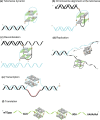G-quadruplexes in viruses: function and potential therapeutic applications
- PMID: 25332402
- PMCID: PMC4227801
- DOI: 10.1093/nar/gku999
G-quadruplexes in viruses: function and potential therapeutic applications
Abstract
G-rich nucleic acids can form non-canonical G-quadruplex structures (G4s) in which four guanines fold in a planar arrangement through Hoogsteen hydrogen bonds. Although many biochemical and structural studies have focused on DNA sequences containing successive, adjacent guanines that spontaneously fold into G4s, evidence for their in vivo relevance has recently begun to accumulate. Complete sequencing of the human genome highlighted the presence of ∼300,000 sequences that can potentially form G4s. Likewise, the presence of putative G4-sequences has been reported in various viruses genomes [e.g., Human immunodeficiency virus (HIV-1), Epstein-Barr virus (EBV), papillomavirus (HPV)]. Many studies have focused on telomeric G4s and how their dynamics are regulated to enable telomere synthesis. Moreover, a role for G4s has been proposed in cellular and viral replication, recombination and gene expression control. In parallel, DNA aptamers that form G4s have been described as inhibitors and diagnostic tools to detect viruses [e.g., hepatitis A virus (HAV), EBV, cauliflower mosaic virus (CaMV), severe acute respiratory syndrome virus (SARS), simian virus 40 (SV40)]. Here, special emphasis will be given to the possible role of these structures in a virus life cycle as well as the use of G4-forming oligonucleotides as potential antiviral agents and innovative tools.
© The Author(s) 2014. Published by Oxford University Press on behalf of Nucleic Acids Research.
Figures




References
-
- Bang I. Untersuchungen über die Guanylsäure. Biochem. Z. 1910;26:293–311.
-
- Sasisekharan V., Zimmerman S., Davies D.R. The structure of helical 5′-guanosine monophosphate. J. Mol. Biol. 1975;92:171–179. - PubMed
-
- Howard F.B., Miles H.T. Poly(inosinic acid) helices: essential chelation of alkali metal ions in the axial channel. Biochemistry. 1982;21:6736–6745. - PubMed
-
- Williamson J.R. Guanine quartets. Curr. Opin. Struct. Biol. 1993;3:357–362.
Publication types
MeSH terms
Substances
LinkOut - more resources
Full Text Sources
Other Literature Sources
Miscellaneous

